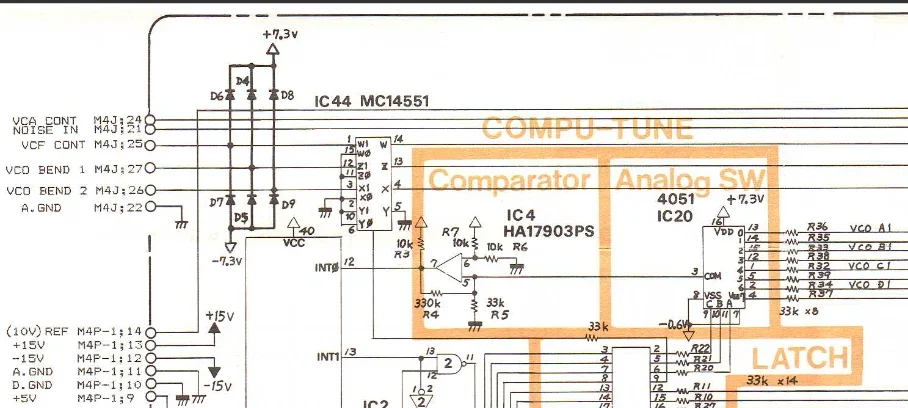Super, danke

Ich habe was auf Gearslutz in dem Bereich gefunden:
Usually an analog synth tuning algorithm works by measuring the frequencies of the VCOs, one VCO at a time, by returning their signal to a frequency counter or comparator IC (there are CMOS switches involved in the routing of the signal back to the counter/comparator). On the Jupiter 6 this is being handled directly on the voice cards, where the schematics identifies the Auto-Tune circuitry as COMPUTUNE. The voice card's CPU, by means of the comparator/counter circuit, measures the VCOs over a range of frequencies and calculates an offset that is being added to the VCO control voltages, in order to make the oscillators producing the right frequencies (= the right notes). When all the VCOs are tuned the voice's board CPU notifies the instrument's main CPU that its job is done.
If all the oscillators on a voice card don't tune the problem could be in the Autotune circuitry, and it usually
regards the CMOS switch ICs and/or the comparator/counter chip. The CMOS switches used in analog synthesizers usually are the 4000 series ICs, quite well known today as a common failure point. And if the Autotune circuitry is faulty it's possible that is driving that voice board's CPU crazy, resulting in the whole synth freezing when trying to invoke the autotuning function from the panel.
To diagnose the computune circuit I'd
start to scope the output of its 4051 CMOS switch (IC20, pin 3) to see if there are VCO signals coming out from it when the Autotune procedure is being invoked from the panel.
Another failure could be in the CV DAC, which in the Jupiter 6 is the now (unfortunately) rare Intersil ITS80141, and there's one on each voice card. To see if the problem resides in the DAC, with the synth set in WHOLE mode make a patch with just white noise and with the filter/amp being modulated by their EGs. If the patch sounds quite consistent over all voices (play different keys so different voices will be fired), both the DACs are OK. If not, compare with the oscilloscope the output of IC12 (the DAC's output op-amp, which is a TL081) on the voice cards, which should look similar for both. If this is the case the DAC is OK and probably there's a problem
in the S/H demux circuitry after it, which is full of 4051 CMOS switches and TL084 op-amps, the latter again being a common failure point in analog synthesizers.
If not, the DAC's output op-amp or the DAC itself on the 4-voice board could have failed.








